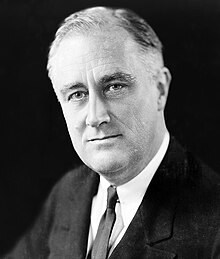This article needs additional citations for verification. (November 2017) |

The first 100 days of Franklin D. Roosevelt's presidency began on March 4, 1933, the day Franklin D. Roosevelt was inaugurated as the 32nd president of the United States. He had signaled his intention to move with unprecedented speed to address the problems facing the nation in his inaugural address, declaring: "I am prepared under my constitutional duty to recommend the measures that a stricken nation in the midst of a stricken world may require." Roosevelt's specific priorities at the outset of his presidency were getting Americans back to work, protecting their savings and creating prosperity, providing relief for the sick and elderly, and getting industry and agriculture back on their feet.[1][2]
He immediately summoned the United States Congress into a three-month (nearly 100-day) special session, during which he presented and was able to rapidly get passed a series of 15 major bills designed to counter the effects of the Great Depression.[1] With President Roosevelt's urging, Congress passed 77 laws during his first 100 days as well, many directed towards reviving the economy of the United States through various public works projects. Following Roosevelt's three terms in office (and just under three months of a fourth term), many other presidents also made significant decisions during their first 100 days.
The 100th day of his presidency was June 12, 1933. On July 25, 1933, Roosevelt gave a radio address in which he coined the term "first 100 days."[1][3] Looking back, he began, "we all wanted the opportunity of a little quiet thought to examine and assimilate in a mental picture the crowding events of the hundred days which had been devoted to the starting of the wheels of the New Deal."[4] Since then, the first 100 days of a presidential term has taken on symbolic significance, and the period is considered a benchmark to measure the early success of a president.
When President Roosevelt took office on March 4, 1933, Congress was not in session. Under the transitional provisions of the recently ratified Twentieth Amendment, Congress was not scheduled to meet until January 3, 1934. As the President declared in his Inaugural Address, “this Nation is asking for action, and action now.” Therefore, he called for a special session of Congress to meet on March 9, 1933. That extraordinary action contributed to the sense of urgency and doubtless enhanced the success of the President's legislative program.
- ^ a b c Walsh, Kenneth T. (February 12, 2009). "The First 100 Days: Franklin Roosevelt Pioneered the 100-Day Concept". U.S. News & World Report. Retrieved 17 January 2021.
- ^ "President Franklin D. Roosevelt Set 100-Day Standard". NPR.org. Retrieved April 27, 2017.
- ^ Alter 2007, p. 273.
- ^ Roosevelt, Franklin D (July 24, 1933). "Fireside Chat 3: On the First Hundred Days". History Muse. Retrieved 17 January 2021.
© MMXXIII Rich X Search. We shall prevail. All rights reserved. Rich X Search
